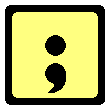 |
 |
PUNCTUATION |
|||||
|
|
|||||||
|
Semicolon
Semicolons can be used to SEPARATE items in a list, especially where commas alone might lead to confusion.
The companies we usually deal with are: Smith, Jones, Weston and partners; Holmes, Watson and Baker; Pendlebury Systems; Thompsons; Carter and Burridge; and Moorlocks.
Semicolons can also be used to GROUP items in a list. This may be for purposes of clarity or merely to make the list more manageable.
You will need to buy: cornflakes, bread, butter and milk; washing powder, polish, scourers and a dishcloth; writing paper, envelopes and stamps.
Notice how each subsection of the list can be treated as a list in itself - with the format:
item, item, item and item.
Semicolons can also be used to JOIN TOGETHER two statements which are closely related. This may signify a cause and effect relationship or it may be that each part says the same thing in a slightly different way.
Brian stood up suddenly; he thought he heard a noise. Sharon, of course, turned up late; she is never on time these days. Lynn is a capable girl; she passed her driving-test first time.
|
|||||||
|
Introduction - Capital letters - Full stops - Question Marks - Exclamation marks - Abbreviations - Contractions - Commas - Speech marks (Quotation marks - Inverted comas) - Possessive apostrophes - Colons - Semi-colons - Brackets - Hyphens - Dashes - Obliques (slashes)
|
|||||||
|
|
|||||||
